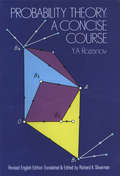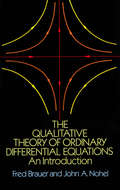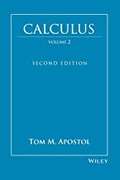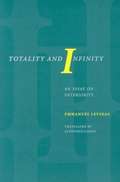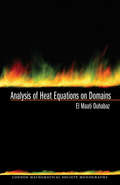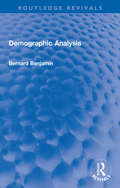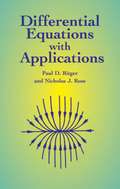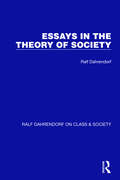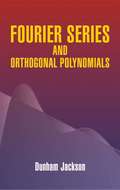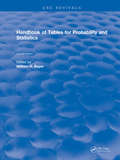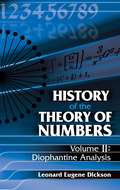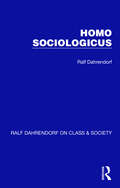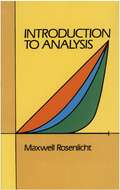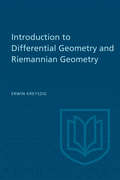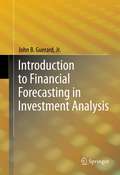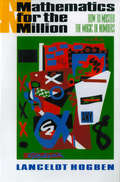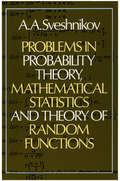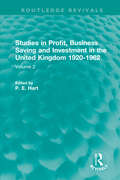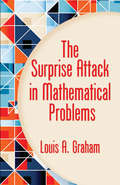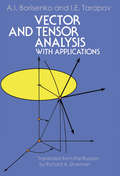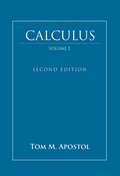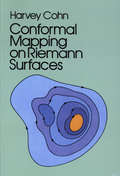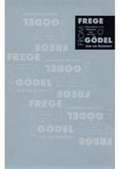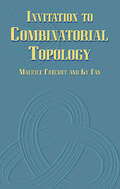- Table View
- List View
Probability Theory: A Concise Course
by Y. A. RozanovThis book, a concise introduction to modern probability theory and certain of its ramifications, deals with a subject indispensable to natural scientists and mathematicians alike. Here the readers, with some knowledge of mathematics, will find an excellent treatment of the elements of probability together with numerous applications. Professor Y. A. Rozanov, an internationally known mathematician whose work in probability theory and stochastic processes has received wide acclaim, combines succinctness of style with a judicious selection of topics. His book is highly readable, fast-moving, and self-contained.The author begins with basic concepts and moves on to combination of events, dependent events and random variables. He then covers Bernoulli trials and the De Moivre-Laplace theorem, which involve three important probability distributions (binomial, Poisson, and normal or Gaussian). The last three chapters are devoted to limit theorems, a detailed treatment of Markov chains, continuous Markov processes. Also included are appendixes on information theory, game theory, branching processes, and problems of optimal control. Each of the eight chapters and four appendixes has been equipped with numerous relevant problems (150 of them), many with hints and answers. This volume is another in the popular series of fine translations from the Russian by Richard A. Silverman. Dr. Silverman, a former member of the Courant Institute of Mathematical Sciences of New York University and the Lincoln Laboratory of the Massachusetts Institute of Technology, is himself the author of numerous papers on applied probability theory. He has heavily revised the English edition and added new material. The clear exposition, the ample illustrations and problems, the cross-references, index, and bibliography make this book useful for self-study or the classroom.
The Qualitative Theory of Ordinary Differential Equations: An Introduction
by John A. Nohel Fred Brauer"This is a very good book ... with many well-chosen examples and illustrations." -- American Mathematical MonthlyThis highly regarded text presents a self-contained introduction to some important aspects of modern qualitative theory for ordinary differential equations. It is accessible to any student of physical sciences, mathematics or engineering who has a good knowledge of calculus and of the elements of linear algebra. In addition, algebraic results are stated as needed; the less familiar ones are proved either in the text or in appendixes.The topics covered in the first three chapters are the standard theorems concerning linear systems, existence and uniqueness of solutions, and dependence on parameters. The next three chapters, the heart of the book, deal with stability theory and some applications, such as oscillation phenomena, self-excited oscillations and the regulator problem of Lurie.One of the special features of this work is its abundance of exercises-routine computations, completions of mathematical arguments, extensions of theorems and applications to physical problems. Moreover, they are found in the body of the text where they naturally occur, offering students substantial aid in understanding the ideas and concepts discussed. The level is intended for students ranging from juniors to first-year graduate students in mathematics, physics or engineering; however, the book is also ideal for a one-semester undergraduate course in ordinary differential equations, or for engineers in need of a course in state space methods.
Test Calculus: Volume 2
by Tom M. ApostolAn introduction to the calculus, with an excellent balance between theory and technique. Integration is treated before differentiation -- this is a departure from most modern texts, but it is historically correct, and it is the best way to establish the true connection between the integral and the derivative. Proofs of all the important theorems are given, generally preceded by geometric or intuitive discussion. This Second Edition introduces the mean-value theorems and their applications earlier in the text, incorporates a treatment of linear algebra, and contains many new and easier exercises. As in the first edition, an interesting historical introduction precedes each important new concept.
Totality and Infinity: An Essay on Exteriority
by Emmanuel Levinas Alphonso LingisFirst published in English by Duquesne in 1969, this has become one of the classics of modern philosophy.
Toward Social Reporting: Next Steps (Social Science Frontiers)
by Otis Dudley DuncanA volume of Social Science Frontiers, a series of publications reviewing new fields for social development, aimed at foundation executives, administrators of research grant programs, directors of research organizations, and others concerned with making contemporary social science more useful for the function of social reporting.
Analysis of Heat Equations on Domains. (LMS-31)
by El-Maati OuhabazThis is the first comprehensive reference published on heat equations associated with non self-adjoint uniformly elliptic operators. The author provides introductory materials for those unfamiliar with the underlying mathematics and background needed to understand the properties of heat equations. He then treats Lp properties of solutions to a wide class of heat equations that have been developed over the last fifteen years. These primarily concern the interplay of heat equations in functional analysis, spectral theory and mathematical physics.This book addresses new developments and applications of Gaussian upper bounds to spectral theory. In particular, it shows how such bounds can be used in order to prove Lp estimates for heat, Schrödinger, and wave type equations. A significant part of the results have been proved during the last decade.The book will appeal to researchers in applied mathematics and functional analysis, and to graduate students who require an introductory text to sesquilinear form techniques, semigroups generated by second order elliptic operators in divergence form, heat kernel bounds, and their applications. It will also be of value to mathematical physicists. The author supplies readers with several references for the few standard results that are stated without proofs.
Demographic Analysis (Routledge Revivals)
by Bernard BenjaminFirst published in 1968, Demographic Analysis was written to provide a comprehensive account of demographic methods for those with a need to understand population movements. The book provides an introduction to some of the key tools used by demographers and the principal sources of population data. Beginning with an overview of the scope, content and use of the population census, it then examines methods for measuring births, deaths, and migration before setting out the methodology for determining the contributions of these elements to population change and estimating past or future changes. The book also explores sickness as a population characteristic and a way of better understanding mortality variations.
Differential Equations With Applications
by Paul D. Ritger Nicholas J. RoseCoherent introductory text focuses on initial- and boundary-value problems, general properties of linear equations, and differences between linear and nonlinear systems. Answers to most problems.
Essays in the Theory of Society (Ralf Dahrendorf on Class & Society #2)
by Ralf DahrendorfOriginally published in 1968, these ten essays by one of Europe’s leading sociological theorists deal with important issues on the borderline between sociology and social philosophy and demonstrate the author’s deep insight into history and political analysis. The author maintains that the structures of power in which the political process takes place not only originate change and give it direction, but also produce the fertile conflicts that give expression to the fundamental uncertainty of human existence. Through an examination of various concepts inherent in this dynamic process – power, resistance, conflict, change, freedom, uncertainty – a coherent theory of society emerges.
Fourier Series and Orthogonal Polynomials: The Carus Mathematical Monographs, No. 6
by Dunham JacksonThis text for undergraduate and graduate students illustrates the fundamental simplicity of the properties of orthogonal functions and their developments in related series. Starting with a definition and explanation of the elements of Fourier series, the text follows with examinations of Legendre polynomials and Bessel functions. Boundary value problems consider Fourier series in conjunction with Laplace's equation in an infinite strip and in a rectangle, with a vibrating string, in three dimensions, in a sphere, and in other circumstances. An overview of Pearson frequency functions is followed by chapters on orthogonal, Jacobi, Hermite, and Laguerre polynomials, and the text concludes with a chapter on convergence. 1941 edition.
Handbook of Tables for Probability and Statistics
by William H. BeyerPracticing statisticians and scientists working in diverse fields need an authoritative reference handbook of statistical tables developed to "aid" in the investigation and solution of many of today's challenging problems. This book has been compiled and arranged to meet the needs of these users of statistics.
History of the Theory of Numbers, Volume II: Diophantine Analysis
by Leonard Eugene DicksonThe three-volume series History of the Theory of Numbers is the work of the distinguished mathematician Leonard Eugene Dickson, who taught at the University of Chicago for four decades and is celebrated for his many contributions to number theory and group theory. This second volume in the series, which is suitable for upper-level undergraduates and graduate students, is devoted to the subject of diophantine analysis. It can be read independently of the preceding volume, which explores divisibility and primality, and volume III, which examines quadratic and higher forms.Featured topics include polygonal, pyramidal, and figurate numbers; linear diophantine equations and congruences; partitions; rational right triangles; triangles, quadrilaterals, and tetrahedra; the sums of two, three, four, and n squares; the number of solutions of quadratic congruences in n unknowns; Liouville's series of eighteen articles; the Pell equation; squares in arithmetical or geometrical progression; equations of degrees three, four, and n; sets of integers with equal sums of like powers; Waring's problem and related results; Fermat's last theorem; and many other related subjects. Indexes of authors cited and subjects appear at the end of the book.
Homo Sociologicus (Ralf Dahrendorf on Class & Society #3)
by Ralf DahrendorfFirst published in English as part of the Essays in the Theory of Society, this volume reissues the stand-alone Homo Sociologicus for which the author wrote a new introduction when it was originally published in 1973. The controversial book deals with the history, significance and limits of the category of social role and discusses the dilemma posed by homo sociologicus. The author shows that for society and sociology, socialization invariably means depersonalization, the yielding up of man’s absolute individuality and liberty to the constraint and generality of social roles. This volume includes the essay, Sociology and Human Nature, written as a postscript to Homo Sociologicus.
Introduction to Analysis
by Maxwell RosenlichtWritten for junior and senior undergraduates, this remarkably clear and accessible treatment covers set theory, the real number system, metric spaces, continuous functions, Riemann integration, multiple integrals, and more. Rigorous and carefully presented, the text assumes a year of calculus and features problems at the end of each chapter. 1968 edition.
Introduction to Differential Geometry and Riemannian Geometry (Mathematical Expositions #16)
by Erwin KreyszigThis book provides an introduction to the differential geometry of curves and surfaces in three-dimensional Euclidean space and to n-dimensional Riemannian geometry. Based on Kreyszig's earlier book Differential Geometry, it is presented in a simple and understandable manner with many examples illustrating the ideas, methods, and results.<P><P> Among the topics covered are vector and tensor algebra, the theory of surfaces, the formulae of Weingarten and Gauss, geodesics, mappings of surfaces and their applications, and global problems. A thorough investigation of Reimannian manifolds is made, including the theory of hypersurfaces. <P> Interesting problems are provided and complete solutions are given at the end of the book together with a list of the more important formulae. Elementary calculus is the sole prerequisite for the understanding of this detailed and complete study in mathematics.
Introduction to Financial Forecasting in Investment Analysis
by John B. Guerard Jr.Forecasting--the art and science of predicting future outcomes--has become a crucial skill in business and economic analysis. This volume introduces the reader to the tools, methods, and techniques of forecasting, specifically as they apply to financial and investing decisions. With an emphasis on "earnings per share" (eps), the author presents a data-oriented text on financial forecasting, understanding financial data, assessing firm financial strategies (such as share buybacks and R&D spending), creating efficient portfolios, and hedging stock portfolios with financial futures. The opening chapters explain how to understand economic fluctuations and how the stock market leads the general economic trend; introduce the concept of portfolio construction and how movements in the economy influence stock price movements; and introduce the reader to the forecasting process, including exponential smoothing and time series model estimations. Subsequent chapters examine the composite index of leading economic indicators (LEI); review financial statement analysis and mean-variance efficient portfolios; and assess the effectiveness of analysts' earnings forecasts. Using data from such firms as Intel, General Electric, and Hitachi, Guerard demonstrates how forecasting tools can be applied to understand the business cycle, evaluate market risk, and demonstrate the impact of global stock selection modeling and portfolio construction.
Mathematics for the Million: How to Master the Magic of Numbers
by Lancelot Hogben"It makes alive the contents of the elements of mathematics."--Albert Einstein Taking only the most elementary knowledge for granted, Lancelot Hogben leads readers of this famous book through the whole course from simple arithmetic to calculus. His illuminating explanation is addressed to the person who wants to understand the place of mathematics in modern civilization but who has been intimidated by its supposed difficulty. Mathematics is the language of size, shape, and order--a language Hogben shows one can both master and enjoy.
Problems in Probability Theory, Mathematical Statistics and Theory of Random Functions
by A. A. SveshnikovProblem solving is the main thrust of this excellent, well-organized workbook. Suitable for students at all levels in probability theory and statistics, the book presents over 1,000 problems and their solutions, illustrating fundamental theory and representative applications in the following fields: Random Events; Distribution Laws; Correlation Theory; Random Variables; Entropy & Information; Markov Processes; Systems of Random Variables; Limit Theorems; Data Processing; and more.The coverage of topics is both broad and deep, ranging from the most elementary combinatorial problems through limit theorems and information theory. Each chapter introduction sets forth the basic formulas and a general outline of the theory necessary for the problems that follow. Next comes a group of sample problems and their solutions, worked out in detail, which serve as effective orientation for the exercises to come.The emphasis on problem solving and the multitude of problems presented make this book, translated from the Russian, a valuable reference manual for scientists, engineers, and computer specialists, as well as a comprehensive workbook for undergraduates in these fields.
Studies in Profit, Business Saving and Investment in the United Kingdom 1920-1962: Volume 2 (Routledge Revivals)
by P. E. HartOriginally published in 1968, this second volume of the Glasgow Studies in Profit, Business Saving and Investment uses the financial data assembled in Volume 1 to test economic theories of the factor distribution income, of the appropriation of profit, of the determinants of investment, and of the return on capital. The tests enabled the measurement of long-run and short-run variation of the ratio of profit to employee compensation in the United Kingdom at the level of individual industries and the whole industrial sector. As well as measuring the relationship between a company’s sales or profits and its expenditure on fixed assets, the book describes the long-term decline in the rate of return on capital in the UK and measures the effect of the intensity of competition on this return.
The Surprise Attack in Mathematical Problems
by Louis A. GrahamFor decades, professionals in applied mathematics and mathematical puzzle fans from all over the world supplied provocative problems to the puzzle columns of the Graham Dial. Upon the appearance of an interesting problem, readers wrote in to the Dial suggesting new approaches to the solution, some greatly simplifying the problem and others broadening its scope. This collection presents 52 of the finest problems, all featuring the "surprise attack" and abounding in imaginative and interesting solutions.The problems involve measurement of geometrical spaces, probabilities, distances, number systems other than the decimal, interesting number relations, relative motion, and the discovery of the simplest solution through purely logical means. Solutions involve such techniques as arithmetic, algebra and geometry, number theory, statistics, networks, and inversion. Several approaches to the solution accompany each problem, and even the best of these represent not the ideal solution but only the most satisfying — so far.
Vector and Tensor Analysis with Applications
by Richard A. Silverman A. I. Borisenko I. E. TarapovConcise and readable, this text ranges from definition of vectors and discussion of algebraic operations on vectors to the concept of tensor and algebraic operations on tensors. It also includes a systematic study of the differential and integral calculus of vector and tensor functions of space and time. Worked-out problems and solutions. 1968 edition.
Calculus, Volume 1
by Tom M. ApostolAn introduction to the Calculus, with an excellent balance between theory and technique. Integration is treated before differentiation--this is a departure from most modern texts, but it is historically correct, and it is the best way to establish the true connection between the integral and the derivative. Proofs of all the important theorems are given, generally preceded by geometric or intuitive discussion. This Second Edition introduces the mean-value theorems and their applications earlier in the text, incorporates a treatment of linear algebra, and contains many new and easier exercises. As in the first edition, an interesting historical introduction precedes each important new concept.
Conformal Mapping on Riemann Surfaces (Dover Books on Mathematics)
by Harvey CohnThe subject matter loosely called "Riemann surface theory" has been the starting point for the development of topology, functional analysis, modern algebra, and any one of a dozen recent branches of mathematics; it is one of the most valuable bodies of knowledge within mathematics for a student to learn.Professor Cohn's lucid and insightful book presents an ideal coverage of the subject in five parts. Part I is a review of complex analysis analytic behavior, the Riemann sphere, geometric constructions, and presents (as a review) a microcosm of the course. The Riemann manifold is introduced in Part II and is examined in terms of intuitive physical and topological technique in Part III. In Part IV the author shows how to define real functions on manifolds analogously with the algebraic and analytic points of view outlined here. The exposition returns in Part V to the use of a single complex variable z. As the text is richly endowed with problem material -- 344 exercises -- the book is perfect for self-study as well as classroom use.Harvey Cohn is well-known in the mathematics profession for his pedagogically superior texts, and the present book will be of great interest not only to pure and applied mathematicians, but also engineers and physicists. Dr. Cohn is currently Distinguished Professor of Mathematics at the City University of New York Graduate Center.
From Frege to Godel: A Source Book in Mathematical Logic, 1879-1931
by Jean Van HeijenoortThe fundamental texts of the great classical period in modern logic, some of them never before available in English translation, are here gathered together for the first time. Modern logic, heralded by Leibniz, may be said to have been initiated by Boole, De Morgan, and Jevons, but it was the publication in 1879 of Gottlob Frege’s Begriffsschrift that opened a great epoch in the history of logic by presenting, in full-fledged form, the propositional calculus and quantification theory. <p><p> Frege’s book, translated in its entirety, begins the present volume. The emergence of two new fields, set theory and foundations of mathematics, on the borders of logic, mathematics, and philosophy, is depicted by the texts that follow. Peano and Dedekind illustrate the trend that led to Principia Mathematica. Burali-Forti, Cantor, Russell, Richard, and König mark the appearance of the modern paradoxes. Hilbert, Russell, and Zermelo show various ways of overcoming these paradoxes and initiate, respectively, proof theory, the theory of types, and axiomatic set theory. Skolem generalizes Löwenheim’s theorem, and he and Fraenkel amend Zermelo’s axiomatization of set theory, while von Neumann offers a somewhat different system. The controversy between Hubert and Brouwer during the twenties is presented in papers of theirs and in others by Weyl, Bernays, Ackermann, and Kolmogorov. The volume concludes with papers by Herbrand and by Gödel, including the latter’s famous incompleteness paper. <p> Of the forty-five contributions here collected all but five are presented in extenso. Those not originally written in English have been translated with exemplary care and exactness; the translators are themselves mathematical logicians as well as skilled interpreters of sometimes obscure texts. Each paper is introduced by a note that sets it in perspective, explains its importance, and points out difficulties in interpretation. Editorial comments and footnotes are interpolated where needed, and an extensive bibliography is included.
Invitation to Combinatorial Topology (Dover Books on Mathematics)
by Ky Fan Maurice Fréchet Howard W. EvesAn elementary text that can be understood by anyone with a background in high school geometry, Invitation to Combinatorial Topology offers a stimulating initiation to important topological ideas. This translation from the original French does full justice to the text's coherent presentation as well as to its rich historical content. Subjects include the problems inherent to coloring maps, homeomorphism, applications of Descartes' theorem, and topological polygons. Considerations of the topological classification of closed surfaces cover elementary operations, use of normal forms of polyhedra, reduction to normal form, and application to the geometric theory of functions. 1967 edition. 108 figures. Bibliography. Index.
